|
present Book Reviews For Amateur & Avocational Archaeologists |
 |
|
present Book Reviews For Amateur & Avocational Archaeologists |
 |
Rock Art & Iconography
|
| Home | Gallery | Latest Finds | Back to Main Book Review Index |

|
The Rock Art of
Texas Indians by Forrest Kirkland & W.W. Newcomb, Jr. University of Texas Press 1996 revision ISBN# 0-292-74326-2 oversized paperback At the behest of his father, who knew of his son’s interest in fossils and Indian artifacts, Forrest Kirkland first visited Paint Rock on his way back from a family reunion in 1933. There he was struck by this “…veritable gallery of primitive art at the mercy of the elements and the hand of a destructive people.” This sparked the beginning of the 38 year old Kirkland’s development into one of the most important and well recognized avocational archeologists in Texas, exercising his in creating watercolors of most of the rock art sites know throughout Texas at the time. Over the next nine years, until his death in 1941, Kirkland and his wife Lula spent their vacations traveling to pictograph and petroglyph sites throughout Texas. He soon became known as an expert in the field, lecturing widely on the subject throughout the Southwest, developing leads on sites from academics, the author A. T. Jackson (who wrote The Picture-Writing of Texas Indians in 1938), as well from working with local ranchers and striking on his own to discover previously unknown sites. Modern archeologists would be appalled by some of his techniques, such as applying water directly to some pictograph panels to bring out details and colors, but none would doubt his contributions to the field. The quality and accuracy of their work recognized by W. W. Newcomb in his 1967 work The Rock Art of Texas Indians, with it’s lavish color and black and white reproductions of 160 Kirkland’s watercolors and an opening chapter on the Kirklands’ adventures. It quickly became the authoritative work the subject, and after almost 30 years as a hard to find classic, the University of Texas Press finally released it again in both hard and soft cover editions. It also features many photographs of the artist at work taken by his wife and maps of some of the sites, allowing the casual armchair reader to share in their exploits without suffering the heat, humidity, rainstorms, grueling travels and inclement beasts the Kirklands often encountered. The opening chapter describes Kirkland’s life, focusing on the adventures of Forrest and Lula as they hunted and captured rock art in the wild, drawing on details from the diaries they both kept of their work. Newcomb then goes on to chapters on rock art in general and throughout the world. Later chapters then narrow down his discussion to specific areas of sites, namely the Lower Pecos, the Big Bend area, the eastern periphery of Central Texas, the Hueco Tanks and the Panhandle. The illustrations are not in chronological order, but there is a key in the back to their numbering sequence which allows one to follow the development of Kirkland’s style over the years. His original work as an artist in landscapes and as an advertising artist with special expertise in mechanical illustrations gave him an eye for detail and scale that plays well in trying to capture features against uneven backdrops and lighting. Kirkland's earliest works of Paint Rock are accurate but rather plain and uninspiring, but he soon began incorporating the rock backdrops into his compositions, projecting a better feel of uneven rock shelter walls onto the flat pages of a book. This, as well as the fact that his later subjects were of much earlier and more interesting styles, made his renderings of works of rock art into works of art themselves. To some extent the reader can also use this book as guide to visiting many of the same sites. While most sites are on private property, Paint Rock is still kept very accessible by the current owner, and both Seminole Canyon and Hueco Tanks are now state parks. The Rock Art Foundation offers seasonal tours of some of the Lower Pecos sites found in the book, and photos which offer an interesting comparison to many of Kirkland’s watercolors can be found at some of the web sites above. Anyone with an interest in prehistoric Texas history and cultures would do well to read The Rock Art of Texas Indians, and for those who find the topic as interesting as Kirkland did it’s still possible to follow in some of his footsteps. The Rock Art of Texas Indians can
be ordered direct from University of Texas Press for either $48.90 for
the hardback, or for $23.42 for the paperback (don't you love Web-only
Specials!) both regularly priced at $70 and $24.95,
respectively----->
Click here
to order. reviewed
by Charles
Swenson
|
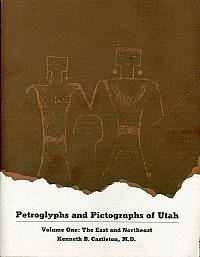
|
Petroglyphs and
Pictographs
of Utah: Volume One: The East and Northeast By Kenneth B.Castleton, M.D. Utah Museum of Natural History 1994 2nd edition ISBN#0-874-80829-4 paperback In typical fashion, we reviewed Volume Two before we received Volume One. How fortunate that Charles Swenson’s review of Volume Two stands as an excellent review of this volume as well, so scroll down for more details. I will simply quote the contents of this volume from the Introduction, so as to differentiate the region discussed within. “Volume 1 deals only with the rock art of northeastern and eastern Utah. For convenience the region is divided into four areascentering around the Uinta Basin, Price, Capitol Reef National Park, and Moab. In relation to drainages, this volume includes the Green River from the Utah-Wyoming line to its point of entrance into Canyonlands National Park, well below the town of Green River, Utah, but above its confluence with the Colorado River, and the Colorado River drainage from the Utah-Colorado line to its entrance into Canyonlands National Park.” Ordering information can be found at the end of the Volume
Two review. Petroglyphs and
Pictographs of
Utah: Utah is incredibly rich in prospects for the avocational archaeologist, and the profuse quantities of rock art which abound there draw the casual viewer into wanting to see more and learn more about the Native cultures which left them behind. The late Kenneth Castleton, a former Professor Emeritus and Dean of Surgery at the University of Utah, first encountered it on a river trip in 1953, and after his retirement he developed his hobby of visiting petroglyph and pictograph sites into a quest for documenting some of the finest sites throughout Utah. A collection of over 12,150 photographs he and his associates took between 1970 and 1985 is now archived at the J. Willard Marriott Library at the University of Utah. Castleton estimates he visited some 450 sites, which is far from all inclusive (the total number probably runs in the tens if not hundreds of thousands) but still a very substantial number of sites. Though he at first sought to archive his data with the University of Utah anthropology department, Professor Jesse D. Jennings encouraged him to publish his data, resulting in the two volumes of Petroglyphs and Pictographs in Utah. This second volume covers over 230 southern and western sites, with 552 illustrations and photographs of some of the pictographs and petroglyphs found there. There are general descriptions of the overall rock art features themselves, as well as associated archaeological features and findings. Dates he visited the sites are included, along with relevant citations in the literature that can then be tracked through the bibliography. Ownership of private sites at the time of his visit is sometimes noted, though most are on public lands and instructions for reaching many of the sites is included for those intrepid souls who desire to see them first hand. Some are very well known (such as Newspaper Rock, which is now a Utah State Historic Park) while some are rarely visited. Interestingly enough, even though the site location descriptions are one of the more valuable aspects of these volumes, the Marriott Library restricts access to his notebooks because of “(t)he very explicit directions to these sites that Dr. Castleton supplied…in order to comply with the Archaeological Resource Protection Act.” This says a great deal about the ongoing vandalism and destruction that still plagues many unprotected rock art sites. Castleton has stated that it was his “observation that many fine panels were being defaced and even destroyed that stimulated my interest in the first place.” Sadly enough, this urge to gainsay the ancients by adding to panels still exists, while some private property owners with petroglyphs have taken to trying to remove them to prevent trespassing; some say that more recent native cultures sometimes obliterate them due to the perceived maleficent influences they exert. Castleton recognized the limitations of his black and white photographs of the sites and speculated on better methods, but they are quite serviceable. The illustrations by Jay Nielson represent the intent of the unknown original artists more clearly in some cases, though they do not do real justice to some of the more degraded multicolored pictographs. It was fascinating to find that some of the “duck-headed men” described in Sandstone Spine (David Roberts, reviewed here) among the San Juan River sites Castleton documented. Aside from however odd that may sound, Nielson’s depictions do show they are indeed quite literally duck-headed men. Many other amusing, sometimes straight forward, sometimes baffling and often truly bizarre images are found in rock art sites, and Castleton has represented a large number of them, making his work not only a functional guide but quite interesting for simply browsing. The opening chapter also deals with rock art styles and chronology as related to Utah, and there is also an illustrated glossary of the basic imagery found. He also discusses at length early written accounts of Utah rock art, with reproductions of some of the earliest published illustrations. Several maps show site locations throughout Utah. An introduction by Castleton to his photography collection at the Marriott Library contains even more background material on Utah Rock art, and can be found here. Many more lavishly illustrated books on Southwestern rock
art are
out there, including many from the University of Utah Press, but
Castleton’s
work remains a true classic in its field. It is especially valuable for
visitors to Utah rock art sites and those seeking new sites to visit.
Volume
1, which covers Eastern Utah sites, focusing on the Fremont culture,
can
be ordered here,
and
Volume
2 can be ordered here,
at the University of Utah Press website, for $24.95 each. reviewed
by Charles
Swenson
|
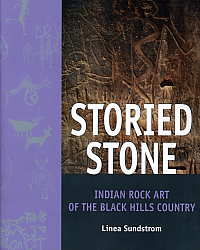
|
Storied Stone Indian Rock Art of the Black Hills Country by Linea Sundstrom University Of Oklahoma Press 2004 1st ed. ISBN# 0-8061-3596-4 oversize paperback Linea Sundstrom has spent the last twenty-plus years studying the rock art found in the Black Hills and presents us with a very readable and fascinating book. Sundstrom had written several books and publications on the topic, including her dissertation, now out of print, and she wanted to write a new book, one that “would focus on the most fascinating aspect of the rock art of the Black Hills and Cave Hills: its meaning and significance as part of the larger world of the Plains Indians.” This is that book, and it updates her other books with all of the latest research and analyses. Sundstrom explains that part of the problem with interpreting rock art is that frequently there are a lot of different styles in the works and often there is superimposition of sometimes up to three layers of pecked and painted art. This makes records of existing rock art all the more valuable if one looks at the entire catalogue of “what’s on top of what”. In this way one can statistically decide which forms came before what other forms. Once motifs are catalogued, certain cultural associations can be made with similar motifs seen elsewhere, say in special clothing worn during rituals. The author breaks the book into chapters that deal with each of the major themes that appear in rock art. The idea of transformation, representations of brave deeds and coup counts, eagle catchers, faces, life-renewal, vision-related and gender-related themes are just some of the iconography discussed. What’s most interesting about this book is the way Sundstrom ties the artwork to Native American tribes who live in the area by discussing tribal beliefs, cultural patterns, and ritual behaviors, ie; the known ethnography of the area. Throughout the book, the author discusses relationships between the rock art and the traditions and motifs associated with Plains Indian tribes We see that Pecked Realistic Art was the genre of hunters, while Pecked Abstract patterns were trance-related and much older, even older than incised and ground rock art found throughout the Great Plains. We learn that the painted designs are more enigmatic, and harder to tie to a time period, some extending into historical times. We see that some can indeed be traced through ancient times to our own. Even the white settlers left their own special kind of graffiti: names, dates, and cattle brands. What we see is an incredible diversity of vision, for whatever reason it was left behind. “The rock art of the Black Hills country does have one thing in common: virtually all of it was made in response to natural surroundings….. The kind of art each group produced reflects the way it viewed the Black Hills country. For some it was a place to take the deer, elk, and bison on which life depended. For others it was a place to seek out visions and mystical power. For some it was a treasure house to be jealously guarded. For some it was the object of pilgrimages; for others, of exploration. Some came to give; some came to take away. Many of them left behind the traces of their passing in the form of engravings, paintings and inscriptions. The story they wrote together is the story of human life in the Black Hills country.” The book has an extensive bibliography and is copiously illustrated with drawings, photographs and many maps. Sundstrom writes with an almost literary descriptive style which makes Storied Stone a pleasure to read. It would be a fine addition to any library of rock art related books. Storied Stone
is available for order direct from the University of Oklahoma Press for
$44.95 by clicking here.
reviewed
by Bob
Wishoff
|
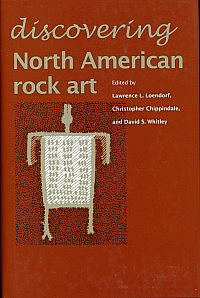
|
Discovering North
American Rock
Art Edited by Lawrence L. Loendorf, Christopher Chippendale, & David Whitley University of Arizona Press 2005 1st ed. ISBN# 0-8165-2483-1 cloth hardback Discovering North American Rock Art is at first glance not what you might expect it to be— there are few illustrations of rock art and the book’s focus is not really on rock art “meaning.” What this book is, is a volume of essays which investigate and discuss the current and historical thinking about rock art research in general, with heavy emphasis on North America. This book is the first volume in 25 years to fully explore this topic for this continent. Rock art, though observed for centuries, having even been noted by early Spanish explorers (who left their own inscriptions dated as early as 1605), and written about in hundreds of papers at all levels of detail, has nonetheless been largely ignored by professional archaeologists. The editors ponder this fact and in a set of excellent, readable essays articulate the many reasons for this situation. In fact, it would seem that everyone but archaeologists have pursued the topic: anthropologists, artists, doctors, architects and avocationalists all have published papers on rock art. So why has professional archaeology ignored rock art as serious fodder for research? Part of the reason may lay in the difficulty of figuring out what the art means: interpreting it at all. Right from the beginning, assumptions were made as to the images’ meanings when they were first called pictographs, or literally, “picture writing.” It was thought that rock art was a literal form of a written language with specific meaning. Those forms that did not fit into picture writing were seen as direct statements of how people saw their world. Thus a large picture of a beast would be interpreted as giant animals, or perhaps the representation of a god. “This easy and seductive approach, which David Lewis-Williams calls “gaze and guess,” produces interpretations of rock art that are imaginative, unfounded, and even crazy.” “If we take a more cautious and securely grounded approach (that the meaning of a picture cannot be determined simply from its appearance), then rock art becomes less visible, even invisible. Although there is a developed anthroplogy of art, scholarship has often stressed the arbitrariness of symbolism and the vagaries of meaning in a symbolic world. Assigning a date to much rock art is difficult, yet dating is so fundamental to archaeological knowledge that undated things are largely left out of archaeological study.” This is truly amazing since there are thousands of rock art sites in North America. What resulted from all of this is a published record unbelievably diverse in its handling of rock art features. While anthropologists wrote up many, many ethnologies which mention and iterate possible meanings and ages for rock art, archaeologists writing up research from a site would often not even mention the rock art present on the site, or just mention it in passing. For years, the obsession with evolving quantitative methods precluded the inclusion of ethnographic “soft” fact into archaeological studies. It was assumed that modern Indians knew nothing about the origins of rock art. The editors point out that only one archaeological field methods textbook in print mentions methods for rock art documentation in any detail (Field Methods In Archaeology, Hester, Shafer, Feder)! So, the first half of the book discusses “Discovering the Images and How We Look At Them”, while the second half of the book discusses “Working with the Images Today.” All total there are twelve essays in the book, all of them very readable, and with so many references that sometimes a short sentence is extended to three or four lines. This makes for a wonderfully tight book that guarantees further study on the topic. The book is actually a very good motivator for further research. As a student, I found myself somewhat inspired to study with what looks like a wide-open field as researchers go back and rethink past analyses and add ethnographic studies to their published archaeological work. Discovering North American Rock Art is a wonderfully well-thought-out volume and a must-have for any library focusing on rock art as a fundamental research area. The literally hundreds of references the authors provide is worth the cost of the book all by itself. The book can be ordered direct from the publisher, for $55.00, by clicking here. reviewed
by
Bob
Wishoff
|
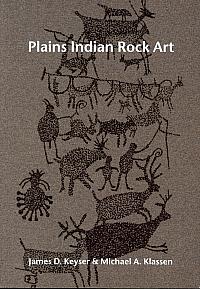 
|
Plains Indian Rock
Art by James D. Keyser & Michael A. Klassen University of Washington Press 2002 1st ed. ISBN# 0-295-98094 paperback Indian Rock Art of
the Columbia
Plateau Here we will introduce you to two fine rock art guides by James D. Keyser, Pacific Northwest Regional Archaeologist for the US Forest Service. Along with Michael A. Klassen, a consulting archaeologist from British Columbia, who co-authored Plains Indian Rock Art, Keyser delivers what he promises. An incredibly thorough book, Plains Indian Rock Art not only successfully attempts to categorize and explain the aforementioned rock art, but also serves out a detailed overview of the area's history as well as ethnographic histories of Native cultures in the region. You will appreciate the logical way that the authors explain how rock art is classified and documented. Starting with the Early Hunting Traditions (which are sorely needing more recording) we learn the various representational and nonrepresentational forms which have been recorded in the Columbia Plateau Tradition, Dinwoody Tradition, En Toto Pecked Tradition, Pecked Abstract Tradition, Foothills Abstract Tradition, Hoofprint Tradition, Ceremonial Tradition, Biographic Tradition, Robe and Ledger Tradition, and Vertical Series Tradition. Each tradition is discussed at length, covering interpretation, and chronology along with the history of research in that tradition also. We are delivered a stunning array and variety of images to ponder! Indian Rock Art of the Columbia Plateau is written in the same style, and with the same depth of treatment of the topic as the Plains book: we just move over a little bit to the West. (I wish the cover were available as a poster--- I love it as it's one of the few illustrations which show the vivid colors rock art is sometimes painted in.) Sometimes great books require but a short review: these books are quite simply great guides to rock art. You need not be living in the detailed regions to have an interest in them. If rock art is your focus, there are few books you'll find as satisfying and complete as these on the topic. Order Plains Indian Rock Art direct from the publisher, for $24.95, by clicking here. Order Indian Rock Art of the Columbia Plateau direct from the publisher, for $19.95 by clicking here. Do yourself and your library a favor
by ordering
both of these great books! reviewed
by Bob
Wishoff
|
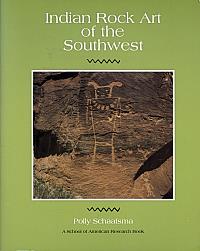
|
Indian Rock Art of
the Southwest By Polly Schaafsma University of New Mexico Press 1980, 1995 6th paperback printing ISBN# 0-8263-0913-5 oversized paperback Indian Rock Art of the Southwest should surely be considered one of the finest published studies of rock art available for study. The Loendorf, Chippindale, and Whitley book Discovering North American Rock Art (reviewed elsewhere here) which is a summary of all research on the topic, states that “Anthropologist and artist Polly Schaafsma (1980) capped more than a decade of study with a survey and synthesis of the rock art of the Southwest that established the basic styles and cultural-historical sequences in use today… this book is profusely illustrated with 283 figures (32 in color) and 11 maps. Schaafsma discusses at length at least twenty different Southwestern rock art styles covering more than three thousand years (table 3.1). Chapters are presented on rock art styles of the Western Archaic hunter-gahterers, Hohokam (called Gila style), Anasazi pre-1300, Fremont, Mogollon, Pueblo post-1300, and Navaho and Apache. Although seven different Archaic styles are identified, many related to Great Basin styles. Schaafsma argues that these abstract styles represent a wide-spread “integrated ideographic system.” I use another’s broad description of the book in my review because it shows this book’s influence in serious rock art studies.. It’s almost impossible to find any study of rock art that doesn’t quote Schaafsma somewhere: her influence and the influence of this study makes it a must-read classic in the field. Currently a research associate of the Museum of Indian Arts and Culture/Laboratory of Anthropology of the Museum of New Mexico, Schaafsma’s extensive career in archaeology and the study of rock art spans many years, and she has become the leading authority in the field. Schaafsma writes: “In many regions of the Southwest, the rock art is a major component of the Archaic archaeological record, and a study of this art contributes significantly to our knowledge of the period." “This volume describes the many rock art styles of the Soluthwest beginning with the oldest and ending with those of the historical period. The styles are examined in their archaeological contexts. Wider stylistic relationships, the origins of styles, traditions through time, and stylistic variation are also mentioned, and their significance is considered within the cultural framework. Whenever possible, the functions that the rock art sites may have served and the meaning of the designs are considered. This study will demonstrate the usefulness of rock art as a tool for widening our understanding of prehistoric cultural systems in the Southwest.” With her careful defining of styles and her structured interpretations of the art placed within cultural contexts, Schaafsma sets the bar and challenges other researchers to increase the importance of often neglected rock art within the archaeological record. If you were to choose but one book on
rock
art, buy this one! It is clearly written in language all can
understand,
and is packed with references which will keep the reader busy following
up on particular interests. There are few other volumes filled with as
many illustrations of rock art as this one. In its sixth printing as a
paperback, order this book direct from the publisher, for $39.95, by
clicking here.
reviewed
by Bob
Wishoff
|
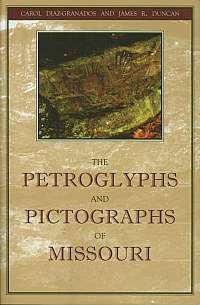
|
The Petroglyphs and
Pictographs
of Missouri by Carol Diaz-Granados and James R. Duncan University of Alabama Press 2000 2nd ed. ISBN# 0-8173-0988-8 paperback Dissertations are an important resource of information about nearly every field of inquiry. Unfortunately, copies of them are most difficult to acquire. Fortunately they are often re-edited into an abridged form and released as a book. The Petroglyphs and Pictographs of Missouri is one such re-issue of a dissertation paper, one created by Carol Diaz-Granados for her PhD. Honoring his editing work, James R. Duncan is given co-authorship of this extensive book. Because of its geographical location straddling the Plains, the Ozarks, and the Southeast, Missouri is an important site for the study of rock art. The authors carefully and exhaustively explore models for rock-art analysis and pull together data from fifty-eight known motifs, including data from Cahokia, forming new models for this important site, and showing relationships between Cahokia and Mississippian cultures. What’s interesting about this book is the way the authors use distribution information to systematically form conclusions about the nature of the motifs explored and discussed. Given that rock art research is a long neglected field in part from the lack of methods and models upon which to form conclusions, The Petroglyphs and Pictographs of Missouri becomes an important book for anyone who wishes to pursue a similar path. An extensive Appendix gives readers a welcome Glossary as well as an extensive listing of Motif Distribution by Site, listing every mofit from every site known in Missouri; there is also a comprehensive bibliography whaich will aid the reader in future research. The Petroglyphs and Pictographs of
Missouri can
be ordered direct from the publishers, for $29.95, by clicking here.
reviewed
by Bob
Wishoff
|

|
The Rock-Art of
Eastern North
America Capturing Images and Insight Edited by Carol Diaz-Granados and James R. Duncan University of Alabama Press 2004 1st ed. ISBN# 0-8173-5096-9 paperback “This volume brings together twenty papers on rock-art research in eastern North America ranging over more than 15 states and four Canadian provinces. Moreover this volume brings together rock-art researchers from a variety of fields. It is well known in rock-art research that this specialized field, ignored far too long by most professional archaeologists, became the domain of avocational archaeologists --- professionals in other fields. In fact, avocationalists have done the lion’s share of rock-art research in North America. Without their records, photographs, slides, and drawings, many of the known sites would have been lost, particularly in the eastern United States. The papers in this volume were researched and written by 18 professional arhchaeologists and an art historian, as well as by a retired orthopedic surgeon, a conservation program director, a carpenter, two photographers, other avocationals, and three graduate students.” This volume “was assembled to reach out to the professional community, to archaeologists, both those who do rock-art research and those who choose to look the other way.” So begins a volume of publications, carefully chosen, which illustrate the length and breadth of research in the topic. There are some differences within this volume that sets it apart from others in the field. There is a paper on dendroglyphs, defined as paintings or carvings on trees, a topic I’ve not seen covered anywhere else. And the section entitled “Survey, Recording, Conservation and Management” contains some very interesting insights on how rock-art is both documented and marketed. Marketing rock-art sites, ie managing them in such a way as to draw visitors toward the interest, yet away from visiting sensitive sites, is worth a read, and unusual to find in a publication. It is apparent that the editors of this volume and the publications’ authors consider many rock-art sites to be in mortal danger of disappearing because of professional archaeologists' general disregard for the importance of rock-art. Another important aspect of this book is that seldom discussed rock-art sites are illustrated within several publications. For example, rock-art sites in Iowa, rarely discussed anywhere else, are shown and placed within context of the better-known sites in the surrounding area. There is considerable time spent examining cups, scored and cupule forms of petroglyphs, across a wider region than in other rock art books. Generally, I like the way the authors make rock-art relevant to the modern reader, whether professional or not. The paper entitled Reflections of Power, Wealth, and Sex in Missouri Rock Art Motifs begins with a decidedly informal style: “When we turn on the television, pick up a magazine, or attend a motion picture film, there is no argument that what we are seeing, simply stated, are reflections of our society’s obsession with power, violence, sex, and wealth. Power manifested in violence, politics, and business prowess. Physical power, power gained by beauty, and power garnered by wealth (often the basis for power), and then sex. The exploitation of sex. Sexually explicit television programs, films, books, poems, rap songs, graphic depictions of sexual acts, and advertising that exploits the power (i.e., selling power) of sexual allure… American Indian oral traditions and stories were not much different in many ways.” The author shows us that people through the ages are still people, however distant their temporal association, and that in the end, nothing has changed--- our interests and expressions are basically the same. Not to say that the publications are not filled with serious research! Physiographic contexts, correspondence, distribution, and frequency analyses are used throughout the papers and help flesh out a complete study of the region. Discussions include the history, ethnography, recording methods, dating, and analysis of the subject sites and integrate these with the known archaeological data. This is truly an important reference for all audiences. The Rock-Art of Eastern North America is a tome worthy of notice. Forty-five pages of cited references are included as an invaluable resource for further research. Order The Rock-Art of Eastern North
America
direct from the publisher, for $34.95, by clicking here.
reviewed
by Bob
Wishoff
|
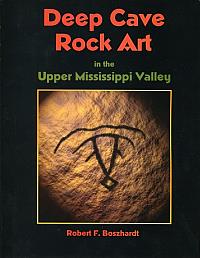
|
Deep Cave Rock Art
in the Upper
Mississippi Valley by Robert Boszhardt Mississippi Valley Archaeological Center/Prairie Smoke Press 2003 1st ed. ISBN#0-9704482-3-6 oversized paperback Studies of rock art found in dark, or deep caves, is just gaining ground and this book is an invaluable reference for such work. Robert Boszhardt, Associate Director, Contracts Director and Regional Archaeologist at the Mississippi Valley Archaeological Center in La Crosse has packed this slim tome with loads of papers and references which will delight the student or researcher in this topic. Boszhardt tells how, because of his job, he was immersed for the first time into the culture of the Oneota, but that “My venture into rock art research was not so straightforward. Indeed, I resisted as long as I could. My reluctance was not because rock art sites weren’t known in the area; in fact one of the first studied rock art sites in the Midwest (Samuels Cave) is located only a few miles east of LaCrosse. Rather, I feared the unknown, or more precisely, what I perceived of as unknowable.” … Nonetheless, being stationed in the scenic, unglaciated Driftless Area of the Upper Mississippi Valley means working in a region that has thousands of rock exposures which lend themselves to rock art. “ He goes on to tell us of his first visit to Samuels Cave, where, “By 1984, a town dump had been established only a few hundred feet from this cave, and upon reaching the entrance we found a tattered easy chair and other trash that had been dragged from the dump.. This and numerous empty beer cans showed that the cave was being used for recreation purposes. Yet, despite the extensive historic defacing and modern irreverence, we saw a few of the original carvings remaining amongst the graffiti. Then, in a flash of unexpected delight, with late afternoon sunlight beaming into the entrance, we saw a panel of charcoal drawings in the back of the cave that had never been recorded before.” What Boszhardt then does is special: he presents projects from their inception through to their completion, showing the reader the whole scope of tasks and thinking involved in rock art research. The seventeen page overview of research of Rock Art in the Midwest and Southwest Wisconsin which starts off the book also includes a well-written summary of the chronology of the area and summary of all regional environmental aspects. Taking advantage of the book’s format (8-1/2” x 11”), Boszhardt gives us clear, large illustrations which do a fantastic job with materials that would have otherwise been hard to see. What follows next are papers on two caves covering their reseach from a to z. Publicity and funding are discussed; Boszhardt even shows us what efforts are needed toward the preservation of cave sites.We are even shown the details of the gating of caves. In short, Boszhardt teaches us about processes that make for good research. I only wish there was more detail about photographic techniques, which are an important part of cave rock art documentation. The topic was discussed in some detail, but, being interested in cave photography, I’d like to know more about exposures and lighting experiments. (Another book, perhaps?) The appendix contains a reprint of 1879 descriptions of Pictured Cave in the La Crosse river valley. Reverend Edward Brown’s paper is a look back in time, giving the reader an interesting alternative perspective on rock art research. There’s also a Glossary and a fine reference section. Overall, I found Boszhardt‘s book perhaps the most practical, and therefore the most useful, of the many rock art topic books I’ve read. Deep Cave Rock Art in the Upper
Mississippi
Valley can be ordered for $25.00 by
clicking here.
reviewed
by Bob
Wishoff
|

|
Roadside Guide to
Indian Ruins
& Rock Art of the Southwest by Gordon and Cathie Sullivan Westcliffe Publishers 2005 ISBN 1-56579-481-8 paperback I first came across this superbly illustrated book at the Gila Cliff Dwellings National Monument gift shop, where it was marked with a “Staff Selection” sticker; the attendant behind the counter exuberantly recommended it and said that she never goes anywhere without it next to her in the front seat. No wonder, for not only is this one of the most complete guides to easily accessible Indian ruin and rock art sites in the Four Corners area, it is one of the most useful. There are clear directions to each, including road conditions, hours of operation, availability of interpretive centers, addresses, phone numbers, nearest supply locations, web site information, fee information, and highlights of each site, all in a conveniently accessible box at the opening of each of the 64 entries. Several sidebars give a more personal feel with some of the authors’ experiences at sites, giving the reader a sense of connection to them as well as to sites. Entries ranging from one to five pages usually include a well researched history of the site, its culture and inhabitants, as well as more contemporary information which will greatly enhance a visitor’s appreciation of the site’s value. There are maps which are unusually complete, with all the road numbers and connecting routes, even including interstate exit numbers; anyone who has ever traveled in this area knows how important this can be! There is an all inclusive map of the four state area, one of each state, and five recommended loop routes for trip planning. But certainly the most striking aspect this book is the remarkably beautiful photography. The authors are also accomplished professional photographers, and their work for this book has produced stunning color portraits of the sites. They’ve captured amazing subtleties in light, landscape and texture over a wide variety of weather conditions. The publishers, who specialize in photography books, are to be commended for their use of a heavy paper stock amenable to excellent image quality, well beyond that often found in soft back books. If you’re fortunate enough to live in the Four Corners area, get this book. If you’ve been there and visited ruins, get this book. If you’re planning a trip to or through the area, get this book. It is an invaluable asset to exploring and understanding the archaeology that is so readily available to visitors there, and for the avocationalist in the area it is a must have book. My only regret is that I didn’t have a copy on my last trip there, and when I go back a copy will certainly be there on the front seat next to me. This and a number of other fine books
can be
found by visiting Westcliffe Publishers at their web site by clicking here. Roadside
Guide to Indians Ruins & Rock Art is a
real bargain at only $22.95. Get it before you go West! reviewed
by Charles
Swenson
|
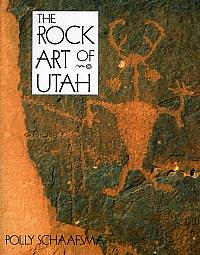
|
The Rock Art of Utah by Polly Schaafsma University of Utah 2006 5th printing ISBN#0-87480-435-3 oversized paperback The copy reviewed is an updated version of the original 1971 classic tome. Copiously illustrated with drawings from the Donald Scott Collection (made in the 1920’s and 30’s) and photographs of rock art examples, this book is a comprehensive tour of all of the styles of rock art to be found in Utah. While not as in-depth as the later published two volume Castleton set (reviewed elsewhere on this page), it nonetheless offers the reader the expert opinions and explanations of one of the field’s most experienced researchers in the topic in Polly Schaafsma. Schaafsma decided not to rewrite the book for its re-publication, but includes more photographs and some new insights gained from current research and interpretation. I think perhaps, though, it is the excellent drawings of Donald Scott that set this volume apart—a researcher interested in the rock art of this region would be well-advised to include this volume in their library. It is also a considerably less expensive option to the two volume Castleton set. The Rock Art of Utah can be ordered directly from the publisher, for $19.95, by clicking here. reviewed by Bob Wishoff |
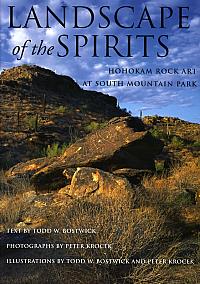 |
Landscape of the
Spirits Hohokam Rock Art at South Mountain Park By Todd Bostwick and Peter Krocek University of Arizona Press 2002 1st ed. ISDN# 0-8165-2184-0 paperback “The urban metropolis of Phoenix is framed on its southern border by a rugged mountain range that rises 1,500 feet (457 m) above the surrounding desert terrain. This mountain range is currently known as the South Mountains. They were once called the Salt River Mountains, and before that the Pima (Akimel O’odham) Indians called them “Muhadag Du’ag” or Greasy Mountain. The Pima have a story about Trickster Coyote, who stole the heart of Rattlesnake’s first victim from its cremation fire. Coyote had to outrun the people who chased him in pursuit. Resting after he crossed the Gila River, Cotote gobbled down his stolen food. Grease dripped from the hot meat, staining the landscape. That is why the mountains north of the Gila River are stained with a dark color.” And what a story to tell… hundreds of interesting examples of Hohokam rock art literally at the ends of streets. I have been to Phoenix fifty times and never once has anyone mentioned the wonderful rock art along the trails of South Mountain Park. Studies at the park are ongoing and the book is meant to represent the locations of all known rock art there. The book does a great job describing the landscape and setting the stage for viewing the art from within Native contexts. There is example of comparative archaeology shown, where a chronology for rock art is postulated by comparing motifs on local pottery finds to those in the rock art. Bostwick also discusses shamanism and the neuropsychological model. The seventy-plus section of Peter Krocek’s color photography is stunning and reproduced on high-quality stock. Bostwick and Krocek’s illustrations are nicely sized, and easy to study along with the well-written text descritions. Eight chapters are devoted to specific types of rock art, one chapter per type, such as “Friends of the Upper World: Birds”. And, if all of the information stuffed into this book isn’t enough for you, the book includes a well-stocked bibliography. I’m looking forward to my next visit to Phoenix. I wouldn’t think of going to the South Mountain Park without this book! A great addition to any rock art oriented library. Landscape of the Spirits is available, direct from the publishers for $27.95, by clicking here. (Also available in hardback for $60.00) reviewed
by Bob
Wishoff
|
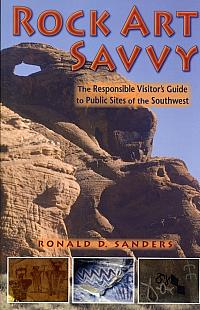 |
Rock Art Savvy : The Responsible Visitor's Guide to Public Sites of the Southwest By Ronald D. Sanders Mountain Press Publishing Co. 2005 ISBN#0-87842-510-1 paperback This is a cool little guide to rock art sites in Arizona, Southern California, Colorado, New Mexico, Nevada, Utah, Western Texas, and Baja California. Author Sanders is serious about the "responsible" part of the title and wastes no time chiding his readers to be respectful of the rock art they encounter. I like the way the book is organized. Part One is filled with chapters about the people and the rock art they created, as well as prevalent theories of what the rock art means. There is also a section about rock art preservation efforts and how readers can get involved in them. Part Two is a straight-forward well-written guide to sites in the regions listed above. Rock Art Savvy is profusely illustrated and a good buy at only $16.00. You can oder it direct from the publisher by clicking here. Mountain Press is a good find-- I like small presses and encourage you all to support them-- they're publishing books you want to read -- take some time to look over their inventory! (Especially their "Roadside" series of history and geology books). reviewed
by Bob
Wishoff
|
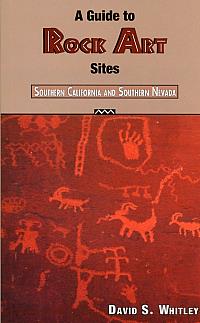 |
A Guide to Rock Art Sites: Southern California and Southern Nevada By David S. Whitley Mountain Press Publishing Co. 2nd printing 2001 ISBN#0-87842-332-X paperback David Whitley is a highly respected, long-time researcher of Rock Art, so it's nice to find a guide to sites authored by him. The author copiously illustrates the guide with his own color photographs. After a fine, informative section which discusses and explains the rock art you will see on the "tour", Whitley's excellent guidebook takes over, clearly describing how to get to some fairly out-of-the-way spots. There are maps, too. (Aren't you glad to hear that?) This is a well-made book, printed on slick high quality paper... in other words it's going to survive being stuffed repeatedly into your backpack. If Southern California and Southern Nevada are places you want to trek to see rock art, and/or you are a serious researcher, this is a great addition to your library. You can oder this guide direct from the publisher, for $20.00 by clicking here. Mountain Press is a good find-- I like small presses and encourage you all to support them-- they're publishing books you want to read -- take some time to look over their inventory! (Especially their "Roadside" series of history and geology books). reviewed
by Bob
Wishoff
|
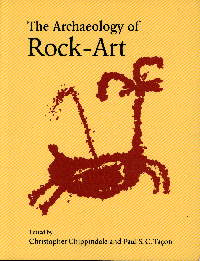 |
The Archaeology of Rock Art Edited by Christopher Chippindale and Paul S. C. Taçon Cambridge University Press 2nd printing 2000 ISBN#0-521-57619-9 paperback A scholarly tome on the topic of Rock Art, this book's 19 chapters cover the gamut of information about the topic. Each chapter is written by an expert in the field and includes chapters by such authors as: Christopher Chippendale, Paul S. C. Taçon, David S. Whitley, Sven Ouzman, Micheal A. Klassen, Thomas A. Dowson, Jean Clottes, Carolyn E. Boyd, Richard Bradley, Kalle Sognnes, Meridith Wilson, Ralph Hartley, Anne M. Wolley Vawser, Benjamin Smith, Pieter Jolly, Anne Solomon, Eva M. Walderhaug, Henri-Paul Francfort, and Jo McDonald. Subjects of the book cover the world's entire range of observed rock art from sites in Paleolithic Europe to 19th century Australia. In the first chapter, the authors lay out an "archaeology of rock art", describing its means, methods, and goals. Succeeding chapters deal with specific sites and areas and their implications in the overall pursuit of understanding the nature of rock art, and why people made it. Read this book and you will inderstand the research approaches professionals use to tease out meaning from these sites. I can't recommend this book highly enough for anyone at all interested in rock art at nearly any level-- It's very thought-provoking and extremely well-written. I have been unable to find a similarly broadly-set book about this topic anywhere. Unfortunately, a peek at the Cambridge University Press finds this book listed as unavailable, out of print, but look around and you will find a copy for under $20.00-- check Amazon and Google. You can see the "official" page for the book at the publisher's website by clicking here-- who knows, it may be back in print sometime after this is written. reviewed
by Bob
Wishoff
|
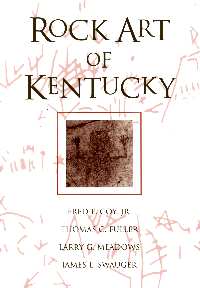 |
Rock
Art of Kentucky by Fred E. Coy, Jr., Thomas C. Fuller, Larry G. Meadows, and James L Swauger The University Press of Kentucky 2007 3rd edition ISBN 978-0-8131-1907-6 Cloth Hardback An extensive photographic guide to all known existant rock art in the state--- this book is a first for Kentucky. This excellent book lists site names and permanent site numbers, making it an excellent reference for either student or professional archaeologist and iconographer. Many of the rock art photos show both centimeter block ruler and a compass. In addition to the photos and locational information, the authors have a description of each instance of rock art. Bibliographic sources and the name of the first recorder of the art are also listed. Of interesting note is the chapter on "Destroyed or Questionable Sites." NOTE! Rock Art of Kentucky is on sale! Order it direct from the publisher for a mere $5.99 - highly recommended!! Get them while they last!!! |
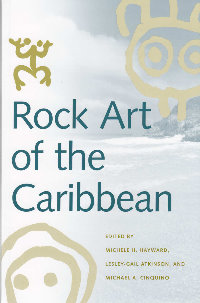 |
Rock Art of the
Caribbean The very existence
of rock art
in the Caribbean is not
widely known, but this volume certainly stands to be recognized as a
definitive
introduction to the subject. Their stated “goal is to add to the
growing
interest and research in the rock art of the area through the specific
aims: 1.
To provide an overview of
Caribbean rock art
from as many areas as possible. Topics
include the history of research, as well as the assessment of sites,
and the
application of methods, interpretive frameworks, and protection
strategies. 2. To collate these authors’ and additional source data to more effectively direct and advance research and conservation efforts in the region.” The chapters are arranged in presentations on specific island groupings, including the Greater and Lesser Antilles, the Bahamian Archipelago, Hispaniola, the Virgin Islands, Trinidad, Tobago, and the southern Caribbean islands off the coast of Venezuela. They are written by local experts with a keen insight into the history of rock art in their specific areas, as well as the topography, typography, iconography, ethnography, and cultural background of the particular locale, as well as conservation considerations and protection of endangered sites. The types of rock art include petroglyphs (carved, pecked and ground stone), and pictographs (monochrome or multicolored, painted or drawn with fingers, sharp wooden tools, cotton bundles or brushes, as well as positive and negative handprints). Motifs include anthropomorphs, simple faces, zoomorphs, concentric circles, geometric designs, and various abstract images. There are some suggestions that the use of a local hallucinogen, cohoba, for communication with local cemi spirits, may have played a role in the production of at least some of the rock art. Locations are often associated with the ocean or fresh water springs. They include caves and rock shelters (most frequently in the case of pictographs due to preservation issues in tropical sites), river valleys, hilltops, boulders, rock outcroppings, beach rock, plazas and ball courts. The earliest time frames are not always clear, with some linear styles perhaps as old as 7000 BC but more generally no earlier than 400 BC or later. Historic elements are occasionally found, and utilization by African slaves, Voodoo practitioners and contemporary populations are not uncommon. One chapter is devoted to an interesting method for imaging rock art site utilizing a linked series of digital cameras and a “red laser stripe generator mounted on a serial-controlled pan/tilt unit” to create “accurate three-dimensional (3-D) textured models of carved surfaces, making the intricate geometry clearly and readily available for study.” A final chapter, ‘The Mute Stones Speak: The Past, Present and Future of Caribbean Rock Art Research’ addresses problems that have hindered this area of study (“geography… developmental history… dating methods… conceptual biases…data set limitations… uneven methodologies ... interpretive concepts”) and offer not only some hints for progress but hope that “…such images from the past will never die but will continue to inform and animate the Antillean cultural landscape, not only for its current inhabitants but also for all humanity.” This nicely illustrated 304 page paperback is available here for $30.95, a rare find for any rock art aficionado. reviewed
by Charles
Swenson
|
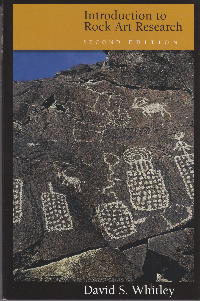 Cover of old edition: 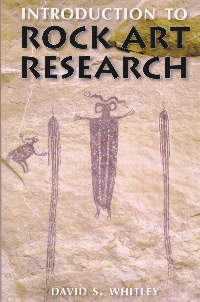 |
Introduction to Rock Art Research Review note for
the second edition:
From the Introduction forward through the
entire document, the reader is guided through the logic and methodology
of rock art research. And there some interesting and not necessarily
obvious elements to researching this topic. For example, writing about
the "selectivity" of rock art research, Whitley notes "that no rock art
documentation is value-neutral, in the sense of providing a complete
and objective record of all of the site data. Whether conscious or not,
all documentation involveschoices about what is importantto record and
whatmay be reasonably left out, given real world constraintslike time
and money. These choices should be made as explicit as possible, and
are ideally definedby an overarching research or site management
problem that defines the fieldwork. The need to define the problem or
objective clearly cannot be overemphasized." Chapters in the book (aside from the
Introduction) are as follows: No serious student of Rock Art studies can
justify not having this book in their library--- it is more than a
book-- it is a tool for research. Order this book direct from the
publisher ($27.95, paperback) by clicking here. reviewed
by Bob
Wishoff |
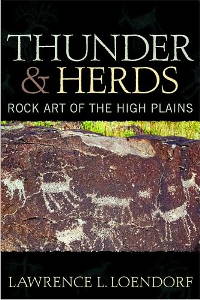 |
Thunder & Herds
Lowendorf writes that "the judgements that
archaeologists make about the meaning and purpose of the rock art they
investigate depend largely on the ideas they bring with them to a site.
for instance, some researchers focus on individual rock art images and
compare them rock art figures at another site. This method of rock art
analysis-- called the iconographic
approach-- is interesting, but not nearly as fruitful as an
examination of a sitewithin its physical context or setting. I call
this fixation with the images at a site to the exclusions of its
surroundings the blinder syndrome."
Loendorf is honest about his "separation"
from sites, in the sense that he understands he was not born into the
tradition that embues sites with mystical power. Though he respects
what Native Americans believe, he admits not being a party to the
prayers said to inhabit a site long after the ancients prayed there--
how refreshing and totally honest! After letting us know how he feels about
the topic, we are treated to an extensive survey of rock art sites
(both petroglyphs and pictographs) throughout the region, and
throughout a chronology that spans from prehistoric through historic
times. Totally readable and understandable, this is a fine book and a
great read. I'd personally love to tour some of the sites men tioned
with Lowndorf's book in hand. He not only describes the sites in
detail, but he has a poet's eye, and writes with a breezy, engaging
style all readers will appreciate. Thunder
and Herds is one of my favorite bookson the topic. I cannot
imagine my library without it! Whether you are interested in rock art,
or in the vast history of the Great Plains, your library will be
greatly benefitted by this book. Pick up a copy diect from the
publisher ($29.95, paperback; $89.00 cloth hardback) by clicking here. reviewed
by Bob
Wishoff |
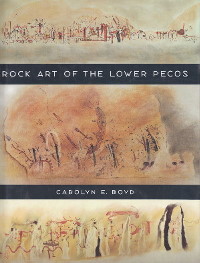 |
Rock
Art
of
the Lower Pecos By
Carolyn E. Boyd Texas
A&M Press 2003 1st ed.
ISBN# 1-58544-259-3 cloth hardcover Rock
Art of the Lower Pecos is one of the most interesting books thus
far published on
the topic of American rock art. Dr. Boyd notes
that
most
archaeologists find it easy to
ascribe the meaning of rock art as merely decorative, or the product of
hallucinatory scribbling, or doodling. In fact, she notes that perhaps
“rock
art” should not be considered “Art” at all. For one thing, the
definition of “Art”
changes over time, as the predominating aesthetic shift, so does the
definition
of what Art is. Boyd notes that “by modern Western definition, the
pictographic
images of the lower Pecos are not Art, nor are the majority of images
from
prehistory that are referred to as ‘rock art’, ‘ceramic art’, “body
art” and so
on… they are “power-full” instruments that serve to express functions
in
specific contexts and are the visual by-products of an essential human
behavior—the behavior of art.” Boyd exhorts us to not be satisfied by
the
aesthetic pleasures of rock art, but thet we should instead, “try to
explain
[rock art] scientifically, recognizing their adaptive, utilitarian, and
functional importance”, thus broadening “our understanding and
appreciation for
the ‘work’ or art—past, present and future.” This
book presents the results of Boyd’s work in the lower Pecos region of
Texas, an
area abundant in rock art. Boyd presents her research plan, one that
integrates
her research with that of other archaeologists, and attempts to utilize
“analogous” methodologies used in other areas of anthropology,
particularly ethnography
and cultural ecology. What
evolves through the course of her research is absolutely mind-boggling.
In
addition to further defining the various styles of art present in the
lower
Pecos area, and refining their chronology, Boyd makes a stunning
conclusion,
that one of the rockshelters contains what is perhaps North America’s
oldest
“book”. She makes a convincing argument that the famous White Shaman
and its
associated pictographs, should be seen as a “whole” image. When one
does this,
the meaning of the mural becomes perfectly clear—it is the articulation
of the
Huichol creation story…. WOW. Rock
Art of the Lower Pecos is a fantastic read. This book
illustrates how much
information can be inferred from rock art. Rock art research, once the
domain
of archaeologists on the fringe, has clearly moved to the
front-of-the-line in
terms of the relevance of data contained within these important
archaeological
treasures. By clicking here,
you
can order Rock Art of the Lower
Pecos directly
from the publisher ($45.00, cloth). More
from the SHUMLA School website” “Our
programs offer an opportunity to shed cultural preconceptions and look
beyond
the taken-for-granted world. Participants gain awareness that all
people share
the same basic needs, emotions, and ways of communicating. Individuals
become
empowered to take responsibility for their social and natural
environment and
begin to bridge the cultural, social, and economic gaps that mark our
society
today. We are truly more alike than we are different, and by
celebrating our
similarities, we can learn to better appreciate and respect our
differences. Each spring,
SHUMLA offers a hands-on course
in rock art recording methodology through the Offices of Extension
Studies at
Texas State University in San Marcos,
Texas. SHUMLA instructors, Dr. Carolyn Boyd and Elton Prewitt, train
undergraduate
and graduate students in the archeology of the Lower Pecos, rock art
recording
and data analysis, field research design, interpretive methods and
theories,
field laboratory procedures, and mapping. Attendees can earn 3–6 hours
of
undergraduate or 3 hours of graduate credit.” I
have personally visited SHUMLA, and camped there. If you and your
family are
looking for a unique experience and wish to see some of the world’s
finest rock
art, I highly encourage you to experience SHUMLA for yourself! Click
the
link for more info: http://www.shumla.org. reviewed
by Bob
Wishoff |
| Home | Gallery | Latest Finds |